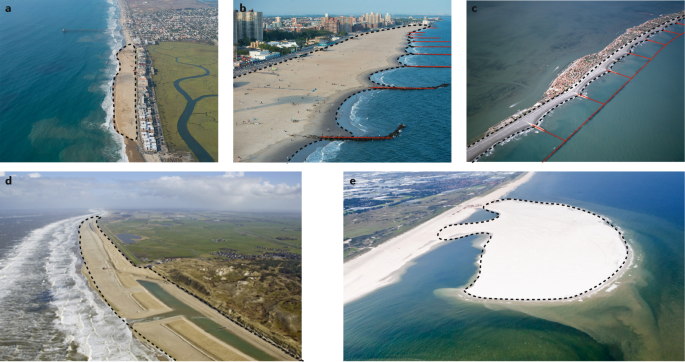4 Simple Techniques For Shore Protect Team
Table of ContentsShore Protect Team Things To Know Before You Get ThisShore Protect Team Things To Know Before You Get ThisThe Greatest Guide To Shore Protect TeamGetting The Shore Protect Team To WorkThe Greatest Guide To Shore Protect TeamThe Facts About Shore Protect Team UncoveredWhat Does Shore Protect Team Mean?
Decline in building worth: As the location tourist is influenced by disintegration, so after that is the economic climate. Buyers are less most likely to look for a coastline house that can be ruined anytime by the approaching flooding and erosion emergency situation. In turn, building value can drop profoundly and affect the entire region.Whether a beach is simply small and crowded or has to shut completely for the safety of the ecological community and close-by residential or commercial properties, this greatly influences tourism. In turn, local economies are influenced (https://www.hometalk.com/member/195484957/shoreprotectteam). Risk of injury: The boosted risk of flooding and architectural failings creates an enhanced risk of injury to close-by vacationers and neighborhood participants

is home to more than 84,240 miles of coast with 41% of it exposed to the open sea. Coastal designers supervise of protecting the coast versus changes by minimizing the destructive effects of both all-natural and synthetic events. Shoreline stabilization is directly relevant to their work. Waterside resorts: Because shoreline disintegration effects tourist, it impacts the success of waterfront hotels.
Not known Facts About Shore Protect Team
Coastal industrial organizations: No vacationers suggests no service. Coastal state parks: State parks that exist along coastlines are at risk of damage.
Hard stablizing utilizes man-made frameworks as protection to regulate disintegration. Many kinds of hard stabilization like seawalls and sheet steel are not ideal for coastline stablizing.
Get This Report on Shore Protect Team
There's likewise insufficient evidence of their effectiveness relying on the kind of coastline and regional problems. Tough stablizing techniques often tend to be harder to install and do not match the natural aesthetic, standing out like a sore thumb and hurting neighborhood ecological communities in lots of situations. Coastline nourishment is the process of adding lost sand and debris back to beaches after erosion has actually occurred.
TrapBags help in the process of beach sustenance by safeguarding natural ecosystems and permitting plants to expand. While this process can be expensive and is not permanent, the pros tend to outweigh the cons. TrapBag barriers deal numerous properties that make them perfect for seaside and shore erosion defense. They're: Ecologically pleasant: You can utilize indigenous dirt both to surround and to fill the TrapBags.

Shore Protect Team - The Facts
They can likewise be mounted without any hefty machinery. Budget friendly: TrapBags are perfect for both small and large areas of shoreline.
The ideal seawall design counts on location-specific aspects, including bordering disintegration processes. There are three primary sorts of seawalls: upright, bent, stepped, and mounds (see table below). A record released by the United Nations Environment Program (UNEP) suggests that the tidal wave of 26 December 2004 triggered less damage in the areas where all-natural barriers existed, such as mangroves, coral reefs or seaside plant life.
All-natural barriers, such as coral reefs and mangrove forests, protect against the spread of tidal waves and the flow of seaside waters and alleviated the flood and surge of water. A cost-benefit technique is a reliable means to identify whether a seawall is suitable and whether the benefits are worth the expense.
Some Known Questions About Shore Protect Team.
A seawall is a fixed function which can contrast with the dynamic nature of the shore and hamper the exchange of debris between land and sea. Advantages and downsides of seawalls according to Short (1999) Benefits Negative aspects Lengthy term remedy in contrast to soft coastline nutrition (https://alivelinks.org/Shore-Protect-Team_507729.html).

This can cause beaches to dissipate, providing them worthless for beach goers. Generally, seawalls can be a successful way to manage seaside disintegration, however only if they are constructed well and out of materials that can stand up to the pressure of recurring wave power. Some understanding is needed of the coastal procedures and morphodynamics certain to the seawall area.
Some Known Facts About Shore Protect Team.
Integrated with a high building and construction cost, this has actually caused raising use of other soft design seaside management options such as coastline replenishment. Seawalls are constructed from different materials, many typically strengthened concrete, boulders, steel, or gabions. Various other possible building and construction materials consist of vinyl, timber, light weight aluminum, fiberglass composite, and biodegradable sandbags constructed from hemp and coir. The appropriate seawall style counts on location-specific aspects, including surrounding erosion processes. There are three major types of seawalls: vertical, bent, stepped, and mounds (see table below).
Natural obstacles, such as reef and mangrove woodlands, stop the spread of tidal waves and the flow of coastal waters and minimized the flood and surge of water. A cost-benefit strategy is a reliable method to establish whether a seawall is proper and whether the benefits are worth the cost.
Indicators on Shore Protect Team You Need To Know
A seawall is a fixed feature which can contravene the dynamic nature of the coastline and hamper the exchange of debris in between land and sea. The table listed below summarizes some positive and negative impacts of seawalls which can be used when contrasting their efficiency with various other coastal management choices, such as coastline nourishment. [] Benefits and negative aspects of seawalls according to Short (1999) Benefits Downsides Long-term remedy in comparison to soft beach nutrition. custom bulkhead designs.

This can trigger beaches to dissipate, making them useless for beach goers. Generally, seawalls can be an effective way to regulate coastal erosion, but only if they are created well and out of materials that can hold up against the pressure of recurring wave energy.